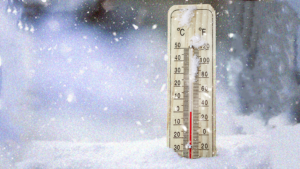
Make your home more resilient to winter weather.
Prepare your home for winter weather so your family stays warm and comfortable. Consider these suggestions for your comfort and safety.
Inspect the Heating System
Performing routine maintenance every year – every other year at least – may help extend the life of your furnace and can promote your family’s comfort and safety. Save time, money and frustration by avoiding the late night or weekend call to a heating contractor because your furnace isn’t working. Spending about $90-$110 for a scheduled service call when it is convenient for you may help avoid the high cost of repairs in an emergency or the risk of having to leave your home until those repairs can be completed.
Prevent Pipe Freezes
Exposed pipes in unheated areas can freeze and result in burst pipes that cause water damage. Use insulating pipe sleeves on the entire length of any exposed pipe, including bends and joints, then seal with duct tape. Letting water drip from faucets may not prevent pipes from freezing in extremely cold weather and can be more expensive.
To prevent damage, take out outdoor hoses. Turn off water to outdoor connections. Open outdoor faucets to let any remaining water drain. Additionally, open kitchen and cabinet doors to allow warm indoor air to circulate around pipes along exterior walls.
If a pipe freezes, don’t attempt to thaw it using any type of exposed flame, such as a propane torch. Try a hairdryer, or call a reputable plumbing contractor for assistance.
Seal Air Leaks
Check exterior window and door frames to ensure no gaps could allow outside air into your home. Any gaps greater than about 1/16 to 1/8 inch should be sealed with a silicone caulk, which is best for exterior use because it won’t shrink and can handle the elements.
Don’t forget to inspect the window pane glazing and replace any areas that have deteriorated.
You’ll also want to check your door seals and weather stripping. Can you see daylight from inside your home? If so, add new seals and weather stripping to further reduce air leaks.
Check the Roof
Inspect the roof system to make sure there aren’t any loose, damaged or missing shingles that can lead to water leaks. Not comfortable climbing the ladder? You can try using binoculars to get a closer look, but you can’t see the entire roof system.
You may want to hire a reputable roof contractor – with proof of insurance coverage – to conduct the inspection. Ask the contractor to look at all roof penetrations, not just the shingles.
Clean your gutters now to prevent water backup if they get clogged with leaves or debris. Clogged gutters that hold water can cause damage to the roof, wood trim and siding and may be a source of leaks and ice dams. Consider installing a gutter guard that keeps gutters free of leaf or other debris and allows the free flow of water.
Do you generally see plenty of icicles during winter months? If so, you may want to hire a home-energy contractor to assess your home’s insulation, especially in attic areas.
Hot air escaping can cause ice dams. Ice dams can damage the roof, wood trim, and siding. Ice dams can also lead to water leaks in your home. Consider installing a rooftop ice melt system to prevent ice dams from forming.
Clean the Chimney
Have a wood-burning fireplace or wood-burning stove? Call a certified chimney sweep to inspect and clean your chimney before using it. If you have a direct vent gas fireplace, it’s important to get a full maintenance inspection. This ensures that the unit and your home properly vent all vents and unburned fuel.
Service the Sump Pump
If you have a sump pump in your home, it definitely works hard during the rainy season and maybe even the snowy season. To check if the pump is working, pour water slowly into an empty or low-water sump. Ensure that you push the water out through the drain pipe to the outside. If you don’t usually do this, remember to turn on your pump once a month, even when it’s not raining.
Do you have a backup plan? If you don’t have one already, consider installing a backup sump pump. This pump should be able to run on either batteries or water. Handling any water that accumulates in your sump pit during a power outage will be helpful.
Provide Smoke and Carbon Monoxide Detection
If you don’t do anything else, make sure you have smoke and carbon monoxide detectors in your home. Many people die in fires because they didn’t have detectors or they weren’t working correctly.
70% of U.S. fire deaths occur in homes without functioning smoke alarms, says the National Fire Protection Association. NFPA further estimates that having operating smoke detection in your home can reduce potential of death by 50%.
Over 20,000 people go to the emergency room in the US every year because of carbon monoxide poisoning, says the CDC. Non-fire-related cases result in more than 400 deaths each year.
Smoke Detection
Recommended locations (preferably powered by home electrical service with battery backup):
- All sleeping rooms
- Outside each separate sleeping area, in the immediate vicinity of the sleeping rooms.
- On each level of the home, including the basement
Carbon Monoxide Detection
Recommended locations (preferably powered by home electrical service with battery backup):
- Outside each separate sleeping area, in the immediate vicinity of the sleeping rooms
- On each level of the home, including basement
Buy smoke/monoxide detectors that connect to your home’s electricity and have a battery backup. If your detectors are battery operated, be sure to test regularly.
This loss control information is advisory only. The author assumes no responsibility for management or control of loss control activities. Not all exposures are identified in this article. Contact your local, independent insurance agent for coverage advice and policy service.
